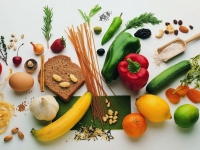In strength sports, such as weight lifting and powerlifting, the main source of energy is the ATP-PC tract (phosphagen system). In short-term strains, the main system used for re-synthesis of ATP is phosphocreatine, which, thanks to keratine kinasis, adds the phosphorus residue to ADP compounds (ADP+PCà ATP+creatine). Phosphagenes stacks, contained in cells, decide on the amount of power that can be availed. Non-oxygen glicose is an additional source of ATP re-synthesis.
Carbohydrates-based energy is used only when long-term strains are involved. Cleans and jerks are too short-termed for carbs to be involved. That’s why lifters don’t really need as much carbs as, let’s say, footballers (70% carbs in diet). Bodybuilders are another category, because they work out with the range of intensity from small to sub-maximum, with non-oxygen through to oxygenized energy transformation. Carbs are a huge part of diet planning. They should be supplied after every workout, to rebuild energy reserves.
Sugars are transported to cells via blood. Every one of us has a quantity of free glucose in our blood, ready for use. To describe the influence of food on our blood sugar levels, Dr. David Jenkins created the glycemic index (IG). IG can have values from 0 to 100, describing the speed of digestion for any given product, and it’s transformation into glucose. The quicker the level of glucose rising in blood, the bigger the index value. The base for any measurement is glucose and other foods are tested in equal quantities. IG is a very useful value, because it shows how the body reacts to carbs.
IG is used by sportspeople to define the needed and supplied carbs in their diet. Low – index carbs (0-55) cause lower rise of blood-sugar, and lower energy output. A pre-workout meal should contain this kind of carbs, so that energy is supplied at a steady pace throughout the whole training. High-IG carbs work well for quicker re-synthesis of glycogen in muscles. Those should be supplied after training. Quicker rise of blood-sugar means also the quicker production of insulin, which speeds up the supply to muscles and their regeneration.
Maciej Sośnicki

